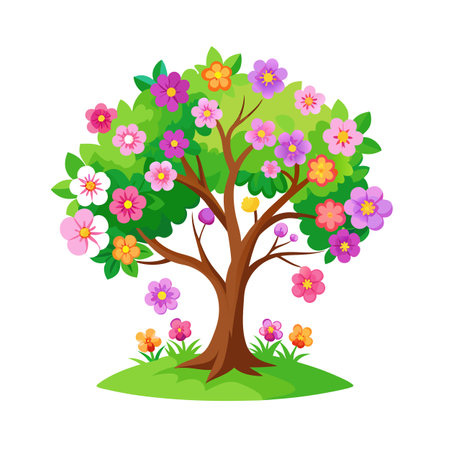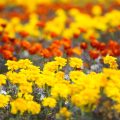1. Understanding the Emotional Impact of Colors
Color plays a powerful role in how we experience a flower garden. Each hue can trigger different feelings and reactions, shaping the mood of your outdoor space. By understanding the psychology of color, you can design a garden that doesn’t just look beautiful—but also feels just right for your personality and lifestyle.
How Colors Affect Mood in the Garden
Our brains respond to colors in subtle yet meaningful ways. Some colors energize us, while others bring calm or even promote introspection. When planning your flower garden, think about the emotional atmosphere you want to create—whether it’s a peaceful retreat, a vibrant gathering space, or something in between.
Common Flower Colors and Their Emotional Effects
| Color | Emotional Impact | Suggested Use in Garden Design |
|---|---|---|
| Blue | Calm, serene, peaceful | Ideal for meditation areas or quiet corners |
| Purple | Imaginative, reflective, spiritual | Add depth to shady spots or restful zones |
| Red | Passionate, energetic, stimulating | Create focal points or energize entrances |
| Orange | Warm, friendly, joyful | Use near patios or social spaces for a welcoming vibe |
| Yellow | Cheerful, uplifting, optimistic | Add brightness to walkways or mixed borders |
| White | Pure, clean, calming | Great for evening gardens or to balance bold colors |
A Tip from American Gardeners:
If youre looking to create a relaxing backyard oasis—a place where you can unwind after work—stick with cooler tones like blues and purples. On the other hand, if your garden is where you love to entertain guests during warm summer nights, reds and oranges can make the space feel lively and inviting.
2. Creating Color Harmony in Garden Design
When it comes to flower garden design, color isnt just about what looks pretty—its also about how it makes you feel. The right combination of colors can create a sense of peace, excitement, or even joy in your garden. Understanding how different color schemes work together can help you build a space that is both visually appealing and emotionally balanced.
Complementary Color Schemes
Complementary colors are opposite each other on the color wheel, such as red and green or blue and orange. When used together, they create strong contrast and vibrant energy. This scheme is great if you want your flower beds to pop and grab attention.
Tips for Using Complementary Colors:
- Use one dominant color and the complementary as an accent to avoid visual overload.
- Try pairing purple salvia with yellow marigolds for a bold summer look.
- Use green foliage as a natural complement to many brightly colored flowers.
Analogous Color Schemes
Analogous colors sit next to each other on the color wheel—like red, orange, and yellow. These combinations offer a more relaxed, harmonious look. They’re perfect for creating a calm and cohesive atmosphere in your garden.
Tips for Using Analogous Colors:
- Select 2–3 neighboring colors on the color wheel for balance.
- Layer flowers from warm (like yellow) to cool tones (like pink) for depth.
- Mix textures and heights within the same color range to add interest without disrupting harmony.
Monochromatic Color Schemes
A monochromatic scheme uses different shades, tints, and tones of a single color. It’s simple but elegant, offering a clean and unified appearance. This approach works well in small spaces or formal gardens where consistency is key.
Tips for Using Monochromatic Colors:
- Choose one base color (such as purple), then add lighter and darker flowers in that same family (like lavender and deep violet).
- Add variety through texture, size, and form rather than color.
- Use silver or green foliage to enhance depth while keeping focus on the main hue.
Quick Comparison of Color Schemes
| Color Scheme | Description | Mood/Effect |
|---|---|---|
| Complementary | Colors opposite on the wheel (e.g., red & green) | Bold, energetic, eye-catching |
| Analogous | Colors next to each other (e.g., yellow & orange) | Cohesive, calming, natural flow |
| Monochromatic | Tints and shades of one color (e.g., light to dark blue) | Sophisticated, soothing, minimalist |
No matter which scheme you choose, always consider how you want your garden to feel. By using complementary for excitement, analogous for peace, or monochromatic for elegance, you can shape not just the look—but also the emotional tone—of your outdoor space.

3. Regional Preferences and Cultural Associations with Color
When designing a flower garden in the United States, color choices are often influenced by regional styles and cultural meanings. Different parts of the country have their own aesthetic traditions and emotional connections to certain colors, which can shape how gardens are designed and experienced.
Patriotic Themes: Red, White, and Blue
In many American communities, especially around national holidays like the Fourth of July or Memorial Day, gardeners love to showcase patriotic spirit through red, white, and blue flowers. These colors symbolize national pride and unity. Popular combinations might include:
| Color | Symbolism | Popular Flowers |
|---|---|---|
| Red | Courage and Valor | Geraniums, Petunias |
| White | Purity and Peace | Alyssum, Shasta Daisies |
| Blue | Loyalty and Justice | Lobelia, Salvia |
Southwestern Earth Tones
The Southwestern region of the U.S., including states like Arizona, New Mexico, and parts of Texas, tends to favor warm earth tones that reflect the desert landscape. Gardeners here often select flowers in shades of terracotta, gold, burnt orange, and dusty pink. These colors not only blend beautifully with adobe-style homes but also thrive under intense sunlight.
Examples of Desert-Inspired Colors and Plants:
| Color Tone | Cultural Influence | Suggested Plants |
|---|---|---|
| Terracotta & Rust | Pueblo Architecture & Clay Pottery | Blanket Flower (Gaillardia), Red Hot Poker (Kniphofia) |
| Golden Yellow & Ochre | Sunlight & Sandstone Cliffs | Coreopsis, Mexican Sunflower (Tithonia) |
| Dusty Pink & Mauve | Cactus Blooms & Desert Sunsets | Purple Coneflower (Echinacea), Autumn Sage (Salvia greggii) |
Northeastern Traditions: Classic and Refined Palettes
In the Northeast—think New England and Mid-Atlantic states—gardeners often favor timeless color schemes with cooler tones. Blues, purples, soft whites, and greens create a calm, elegant garden style that complements the region’s colonial architecture and lush landscapes.
Popular Northeastern Garden Colors:
- Lavender: Symbolizes tranquility; great with hydrangeas or catmint.
- Pale yellow: Softens formal layouts; try daylilies or coreopsis.
- Sage green: Found in foliage plants like lamb’s ear or hostas.
Southeast: Bold Tropicals and Vibrant Hues
The hot and humid Southeast favors bold tropical colors that echo the lushness of the environment. Bright reds, oranges, hot pinks, and yellows are common in flower beds from Florida to Georgia. These vivid hues stand up well to strong sunlight and high humidity.
- Tropical Red: Hibiscus or Cannas for a dramatic effect.
- Bright Orange: Marigolds or Bird of Paradise for warmth.
- Lime Green Accents: Coleus or ornamental grasses for contrast.
This regional approach to color not only reflects local culture but also enhances how we connect emotionally with our outdoor spaces. Whether youre inspired by your state’s heritage or simply want your garden to feel at home in its surroundings, choosing colors based on regional preferences can make your flower garden more meaningful and visually harmonious.
4. Seasonal Color Psychology
Our emotional response to color can change with the seasons, and understanding this can help create flower gardens that feel harmonious year-round. Each season brings its own mood and atmosphere, which can be enhanced or balanced by thoughtful color choices in your garden design.
Spring: Renewal and Optimism
Spring is a time of renewal and fresh beginnings. People often associate this season with feelings of hope, joy, and energy. Pastel tones like soft pinks, baby blues, and light yellows reflect this mood perfectly. These colors bring a gentle vibrancy that complements the fresh growth and blooming flowers.
Summer: Energy and Celebration
Summer is all about warmth, vitality, and celebration. Bold colors like bright red, orange, hot pink, and sunny yellow stir up feelings of excitement and activity. Designing your garden with these vivid hues helps match the high energy of long summer days.
Fall: Comfort and Reflection
As temperatures cool down, fall invites introspection and comfort. Earthy tones like deep oranges, burgundy, golden yellows, and warm browns echo the changing leaves and bring a sense of coziness to your garden space.
Winter: Calm and Rest
Winter often carries a quiet stillness. Colors like icy blue, silver, white, and deep evergreen promote calmness and restfulness. Though fewer flowers bloom during winter, using evergreens or winter-blooming plants in these shades can maintain emotional balance in your outdoor space.
Seasonal Color Guide for Emotional Impact
| Season | Common Emotions | Recommended Colors |
|---|---|---|
| Spring | Hopeful, Joyful, Energized | Pastels (pink, light blue, soft yellow) |
| Summer | Excited, Active, Social | Bright hues (red, orange, yellow) |
| Fall | Cozy, Reflective, Grounded | Earth tones (orange, burgundy, gold) |
| Winter | Calm, Restful, Peaceful | Cool tones (white, blue, evergreen) |
Design Tips for Seasonal Harmony
- Rotate annuals: Choose seasonal annuals that align with each season’s color palette to refresh your garden’s look every few months.
- Add perennials strategically: Use perennials that bloom at different times of the year to ensure continuous color flow across seasons.
- Incorporate foliage: Don’t overlook colorful foliage—many plants offer stunning leaf colors in fall and winter when flowers are scarce.
A garden designed with seasonal color psychology in mind can enhance your mood throughout the year. By syncing plant colors with seasonal emotions, you create a more immersive and emotionally supportive outdoor space.
5. Using Color to Define Space and Function
In flower garden design, color isnt just about beauty—its also a powerful tool for organizing your outdoor space. By using specific colors in different parts of your garden, you can create zones that serve different purposes like relaxing, entertaining, or playing. This approach enhances both the look and the usability of your garden.
Color Zones for Different Activities
Think of your garden as a series of “rooms,” each with its own function. Just like in your home, color can help define what happens in each space. Heres how:
| Garden Zone | Recommended Colors | Psycho-Emotional Effect |
|---|---|---|
| Relaxation Area | Cool tones (blue, lavender, soft pink) | Calming, soothing, helps reduce stress |
| Entertainment Space | Warm tones (red, orange, yellow) | Inviting, energizing, encourages conversation |
| Children’s Play Zone | Bright primary colors (red, blue, yellow) | Fun, stimulating, visually engaging |
| Meditation or Yoga Corner | White and green with touches of purple | Peaceful, serene, promotes mindfulness |
| Transition Pathways | Neutral tones (white flowers, silver foliage) | Cleansing visual break between areas |
Tips for Applying Color Strategically
Select a Purpose First
Before choosing plants, think about how you want to use each section of your garden. Are you hoping to host summer BBQs? Or maybe you need a quiet space for evening reading? Let that purpose guide your color palette.
Create Visual Boundaries with Color Blocks
You can use color groupings to subtly signal where one zone ends and another begins. For example, planting a row of bright orange marigolds might mark the start of your entertaining area.
Use Repetition for Flow
Repeating certain colors across different zones can help unify the entire space while still maintaining functional separation. A touch of white in every area can tie everything together while allowing each zone to shine on its own.
The Role of Seasonal Change
Your color zones don’t have to stay the same all year round. Use seasonal blooms to refresh each zones mood—cool blues in spring can transition into warm yellows and reds for summer gatherings.
Pro Tip:
If youre short on space, use container gardens with different color themes to define mini-zones on patios or balconies. Its an easy way to bring purposeful color into even the smallest outdoor areas.
By thinking strategically about color placement in your flower garden, you’re not just planting pretty blooms—you’re designing an outdoor environment that supports how you want to live and feel in that space.
6. Incorporating Personal Expression Through Color
When designing a flower garden, color choices can be much more than just aesthetic decisions—they can be deeply personal. Colors have the power to reflect your personality, tell your story, and even evoke cherished memories. That’s why incorporating personal expression through color is a meaningful way to make your garden truly yours.
Let Your Garden Tell Your Story
Think of your garden as a blank canvas where you can paint with colors that speak to your heart. Maybe bright sunflowers remind you of childhood summers, or soft lavenders bring back memories of a peaceful vacation in the countryside. These emotional connections can guide your color palette and turn your garden into a living reflection of who you are.
Examples of Personal Color Choices
| Color | Possible Personal Meaning | Suggested Flowers |
|---|---|---|
| Yellow | Joy, optimism, happy memories | Sunflowers, daffodils, marigolds |
| Purple | Calmness, spirituality, nostalgia | Lavender, salvia, irises |
| Red | Passion, love, energy | Roses, tulips, geraniums |
| White | Simplicity, peace, remembrance | Lilies, daisies, hydrangeas |
| Pink | Tenderness, romance, affection | Zinnias, peonies, cosmos |
Tips for Expressing Yourself Through Garden Color
- Start with what you love: Choose colors that naturally draw you in or make you feel good.
- Use color to create moods: Calming blues and purples can create a peaceful retreat; bold reds and oranges add excitement.
- Create a memory corner: Dedicate a section of your garden to flowers that remind you of special people or places.
- Add seasonal variety: Let your personal expression evolve throughout the year by planting flowers that bloom in different seasons.
- Mix in favorite accessories: Use colorful pots, garden art, or furniture to complement and enhance your flower choices.
Your Garden is Uniquely Yours
No two gardens need to look alike—just like no two gardeners are the same. By choosing flower colors that resonate with your emotions and experiences, youre not just designing a space; youre creating a place that feels like home. Whether it’s vibrant and full of life or serene and soothing, let your garden reflect who you are at heart.


